Sarajevo is a beautiful, interesting city with a sometimes tumultuous history. In this post I’ll give a brief intro to the city and its history followed by my recommendations of things to do while in Sarajevo as well as a fantastic day tour out of the city.
Intro to Sarajevo
Sarajevo is the capital of Bosnia and Herzegovina in southeastern Europe. It is nestled in a valley surrounded by mountains near the center of the country. The city fills the small flat section of land hugging the Miljacka River and continues up the steep hills surrounding the river. It is a city where “the east meets the west” because of the influences from both the Ottoman and Austro-Hungarian empires. Sarajevo has mosques, Orthodox churches, Catholic churches and a few synagogues all within close proximity showing the peaceful coexistence it had for centuries. The call to prayer as well as church bells are still heard throughout the city multiple times daily. This peace collapsed for a time and now Sarajevo bears the scars of a 1,425 day siege during the Bosnian War.
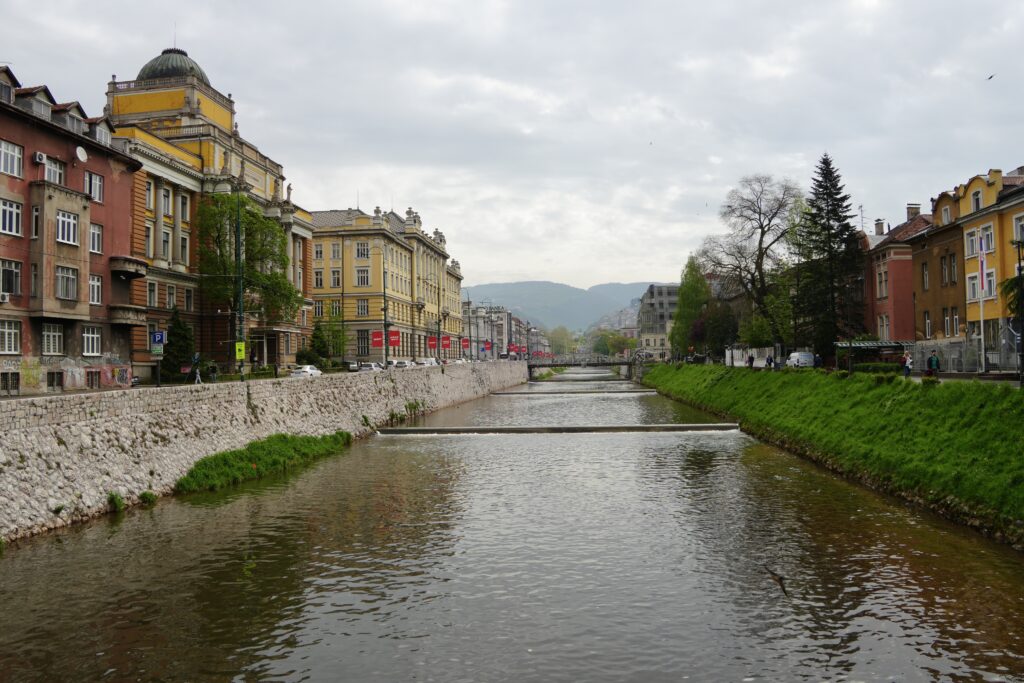
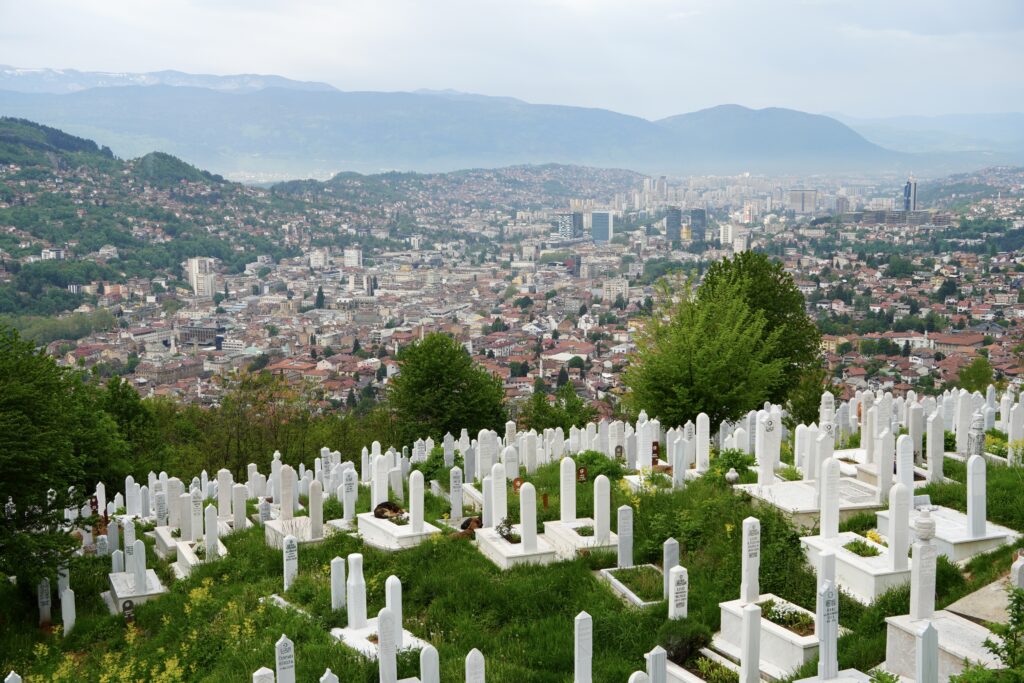
Brief History of Sarajevo
The land that is now Bosnia and Herzegovina has had a long and constantly changing history. There is evidence of the area being inhabited since at least the Stone Age. The Illyrian tribes were creating kingdoms there in the 8th century BCE and Celts were invading by the 4th century BCE. Later it was part of the western Roman Empire, then taken by the Ostrogoths, the Alans, the Huns, and then taken by the Byzantine Empire by the 6th century CE. Slavs entered the area in the 6th and 7th centuries and Bosnia eventually became under its own rule. In 1377 Tvrtko was crowned the first king of the Kingdom of Bosnia.
In 1463 the Ottoman Empire conquered the area and the Kingdom of Bosnia no longer existed. With the Ottoman Empire came the conversion of much of the population to Islam. After the Turkish-Russian War, the area of Bosnia and Herzegovina was given to the Austro-Hungarian Empire in 1878 (to counterbalance Russia’s influence in the area as its allies Serbia, Romania, and Montenegro gained independence). Bosnian Serb nationalists wanted to be free of occupation and be part of a Slavic nation. This led to the assassination of Archduke Franz Ferdinand in the city of Sarajevo in 1914 which caused a cascade of events that led to World War I.
After WWI, Sarajevo and the rest of Bosnia and Herzegovina became part of the Kingdom of Yugoslavia. It was occupied by the Nazis for a while during WWII. Under the leadership of Marshal Josip Broz Tito, locals expelled the Nazis before WWII ended. After WWII Yugoslavia became a communist state with Tito as its leader. After Tito’s death, rising ethnic nationalism led to parts of Yugoslavia wanting independence. When Bosnia and Herzegovina declared independence in 1992, many Bosnian Serbs wanted the country to be Serbian, and there was also a movement by Croats for parts of the country to become part of Croatia. Bosnian Serbs attacked Sarajevo which had a very mixed ethnic population. A devastating siege on the city of Sarajevo lasted for 1,425 days.
The war ended in 1995 with Bosnia and Herzegovina as an independent nation. However, it was structured with a very complicated government. Essentially the country is divided into two main parts: the Federation of Bosnia and Herzegovina, populated primarily by the Bosnian Muslim and Croatian ethnic groups; and the Republika Srpska, populated primarily by Serbian ethnic groups. There is also a third small, neutral, ethnically mixed part called the Brick District. There are three presidents, one from each ethnic group (Orthodox Serb, Catholic Croat, and Muslim Bosniak), and they share the presidency for 8-month rotations in a four year term. I don’t believe I can explain the situation well enough, so I will stop there. However if you are interested in learning more about the country, I recommend reading the Cultures of the World book on Bosnia and Herzegovina by David C. King or doing further research yourself.
What to do in Sarajevo
Wander Cobblestone Streets of Baščaršija
Baščaršija is Sarajevo’s old bazaar and was the main trading area during Ottoman rule. Around 1460 the foundations for Sarajevo were set here and it became the largest trading center in the Balkans. Pedestrian cobblestone streets weave between low rise traditional Ottoman architecture. The Baščaršija is a bustling area filled with locals and tourists alike these days. There are lots of cafes, sweet shops, and souvenirs.
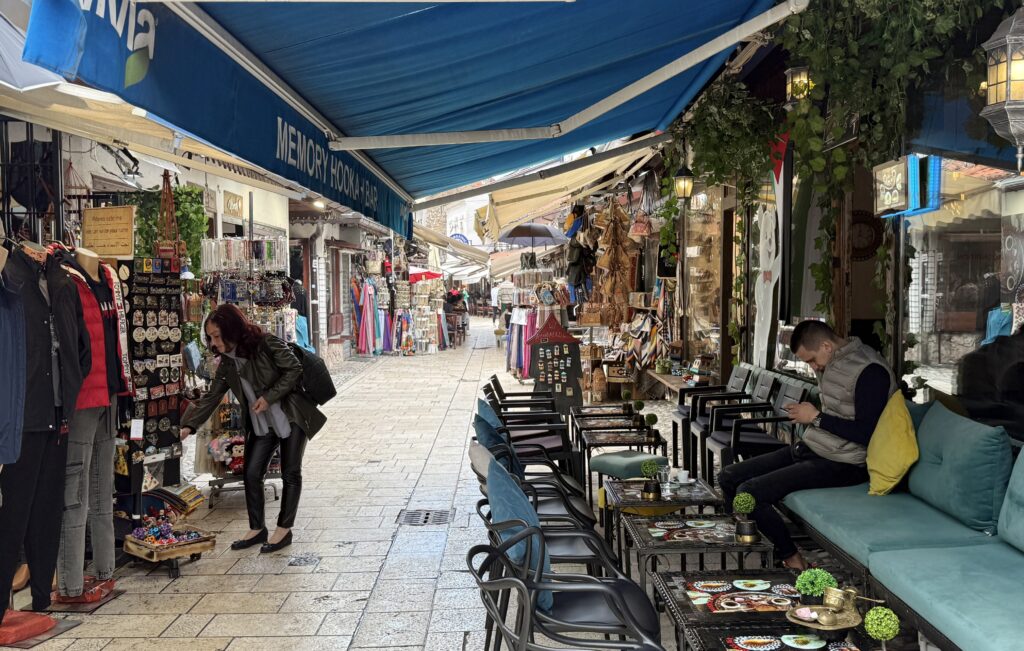
Shop on Kazandžiluk Street
Coppersmiths have been working on Kazandžiluk Street since Ottoman times. These days they create local souvenirs for the tourists that explore the narrow alleyways. Artisans can be found working in their shops, the sound of their hammering heard from the streets. Wander through the alley of Kazandžiluk Street in Baščaršija to see these beautiful crafts on display. I really liked the colorful traditional coffee sets and intricately etched tea sets for sale.
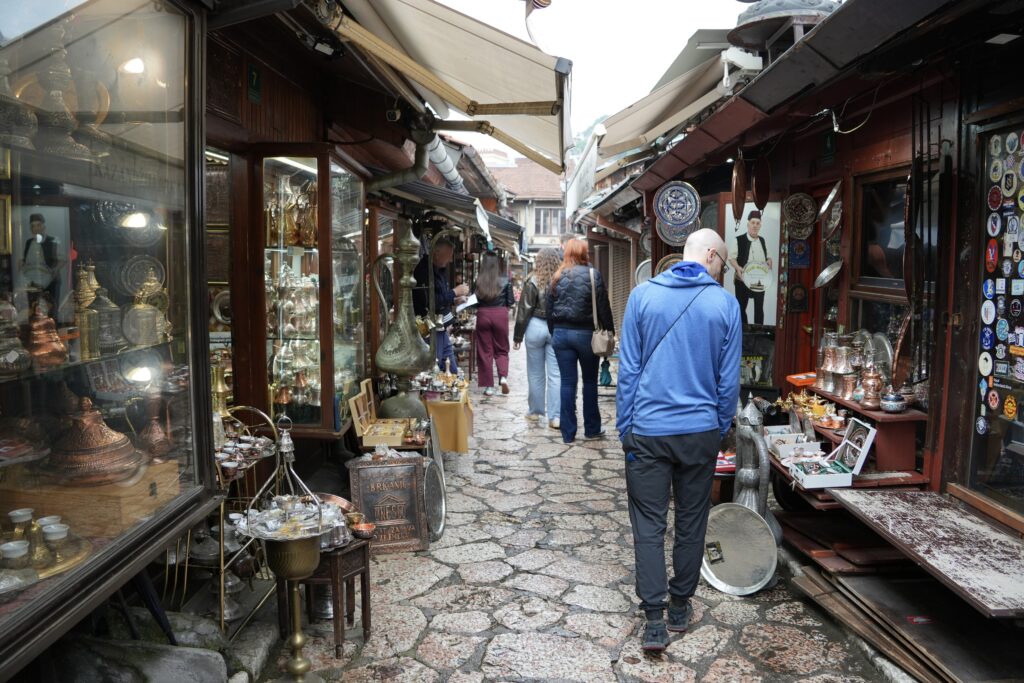
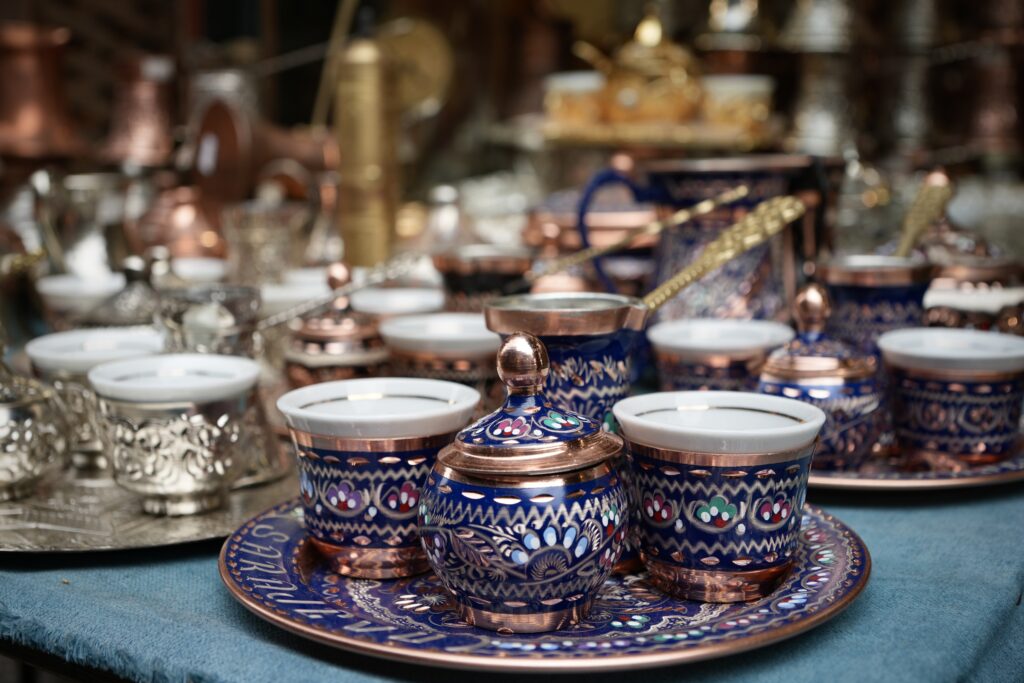
Sebilj Fountain
The Sebilj is an Ottoman style wooden fountain in the main square (also known as Pigeon Square) of the Baščaršija. It was originally built in 1753 but destroyed by a fire in 1852. It was then reconstructed in 1891 by an Austrian architect. There is a local legend that anyone that drinks from the fountain will someday find themselves back in Sarajevo.
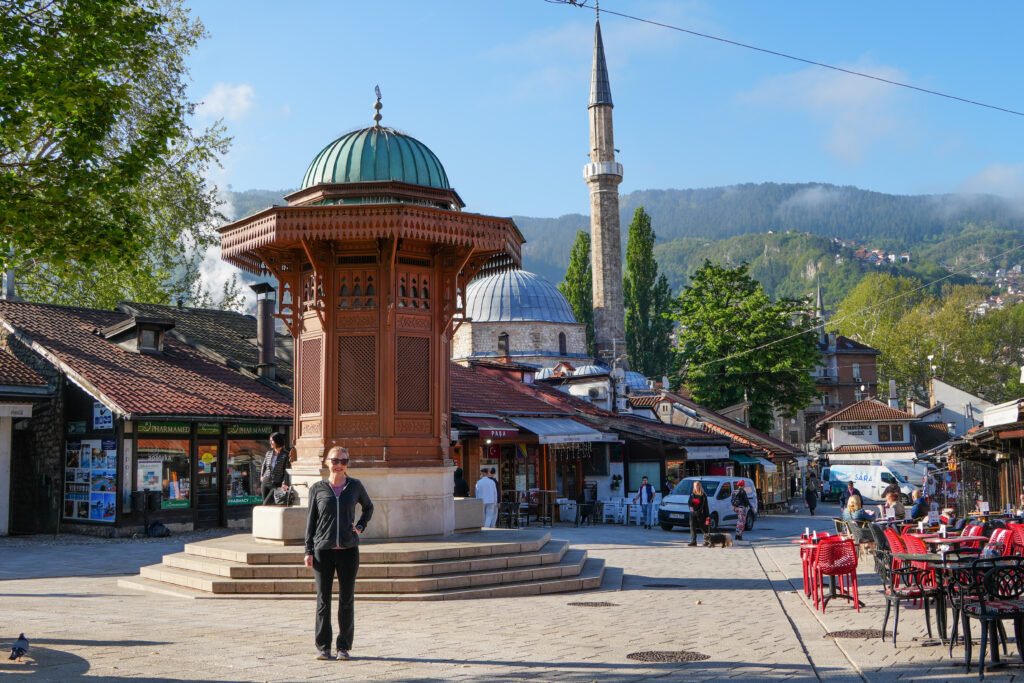
Old Clock Tower
The 16th century Old Clock Tower is a lunar clock indicating the times for the 5 daily prayers in Islam. According to the clock, the day begins at sunset when the time shows 12:00. A man with the titled job of “muvekit” recalibrates the time to keep it accurate for Sarajevo’s Islamic prayer times. He has been climbing the tower twice weekly since 1967 even throughout the Bosnian War.
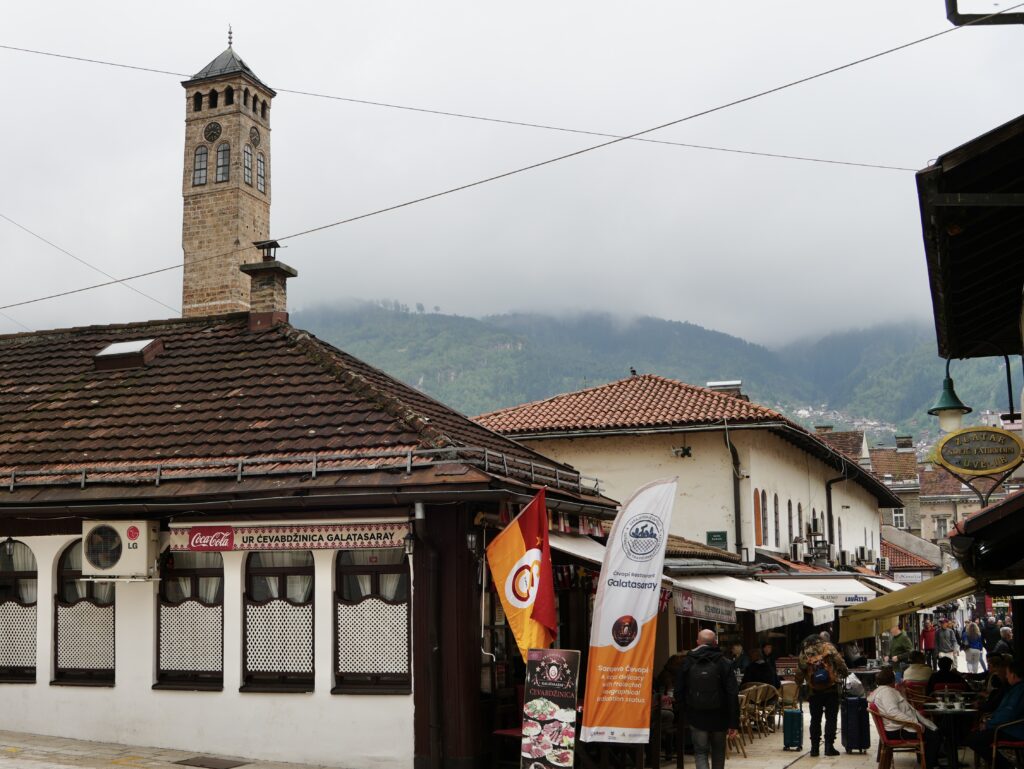
Gaza Husrev-beg Mosque
Gaza Husrev-beg Mosque was built in 1531. An open courtyard with a large fountain for ceremonial washing is just inside the walls around the mosque. This is considered the most important architectural monument in Sarajevo from the Ottoman period. It is found in the center of the Baščaršija area.
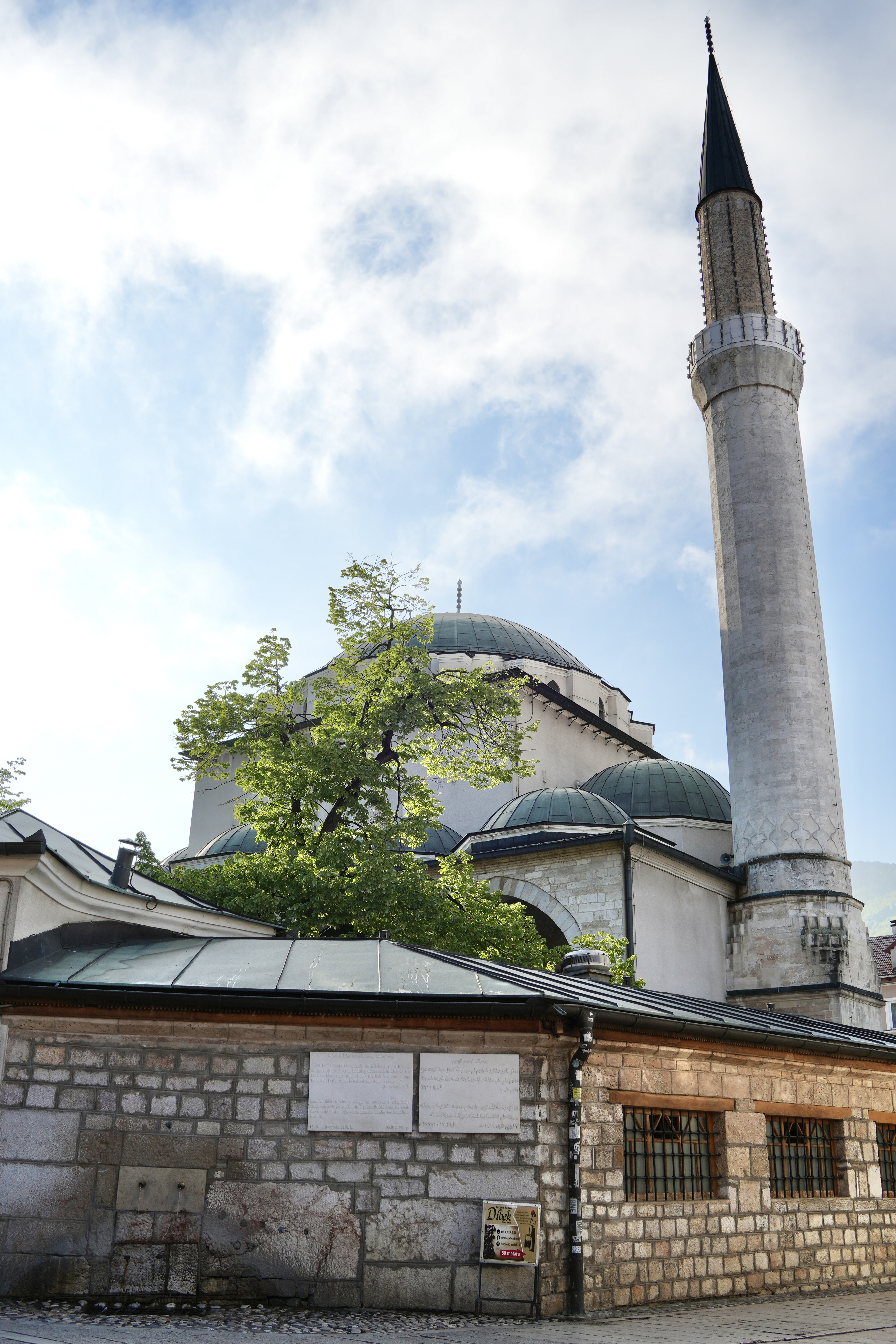
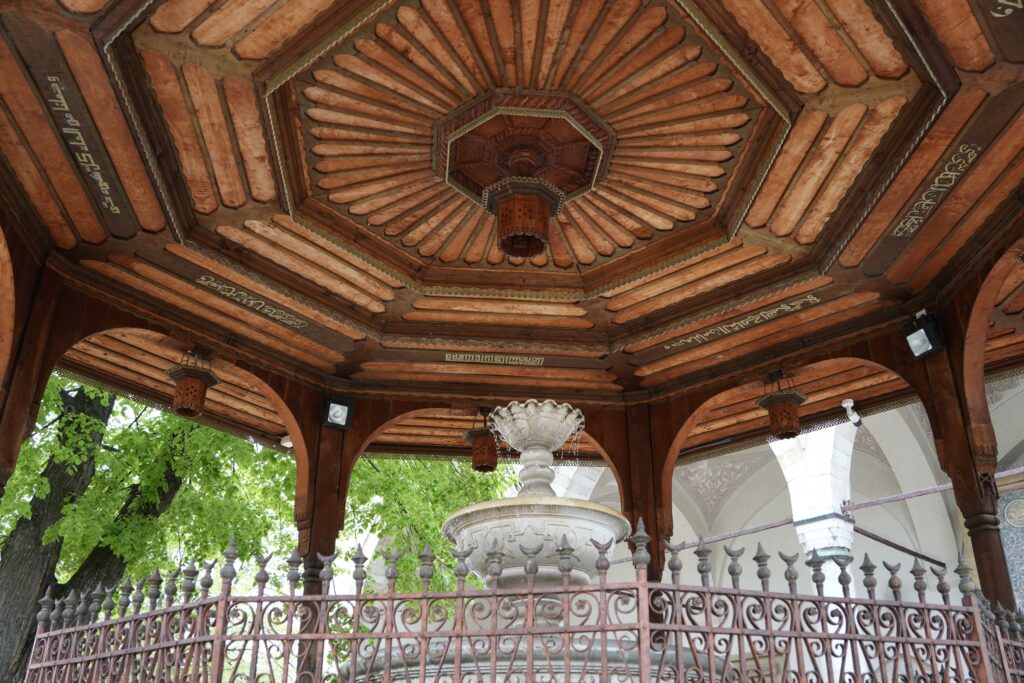
The Old Synagogue
The Old Synagogue was built in 1581 in what was then a small Jewish neighborhood in the Baščaršija. Two big fires occurred over the years and its current design is from the reconstruction in 1813. It was converted into the Jewish Museum of Bosnia and Herzegovina in 1966. A newer synagogue was built right next to it.
The Old Orthodox Church
The Church of the Holy Archangels Michael and Gabriel which is commonly known as the Old Orthodox Church was established in 1539. It was built during Ottoman period and served the Orthodox Christians under Ottoman rule. It is a simple stone structure with a bell tower and a short stone wall surrounding it.
Tašlihan
Tašlihan is the archeological site where you can see the ruins from a stone inn (a caravanserai) that was built around 1540. There were 3 of these caravanserai in Sarajevo during the Ottoman period. Caravanserai were inns for travelers, merchants, and caravans and were common in much of the Islamic world. It was a fort like structure that could accommodate an entire traveling group along with their horses. A fire in 1879 completely destroyed it and most of the remains removed. When the Europe Hotel (which was built on top of this site) was being renovated and expanded, the foundations of part of the old inn were uncovered and it was decided to make this area an archeological site and preserve it. The foundation and a large wall are what still exists of this Ottoman inn.
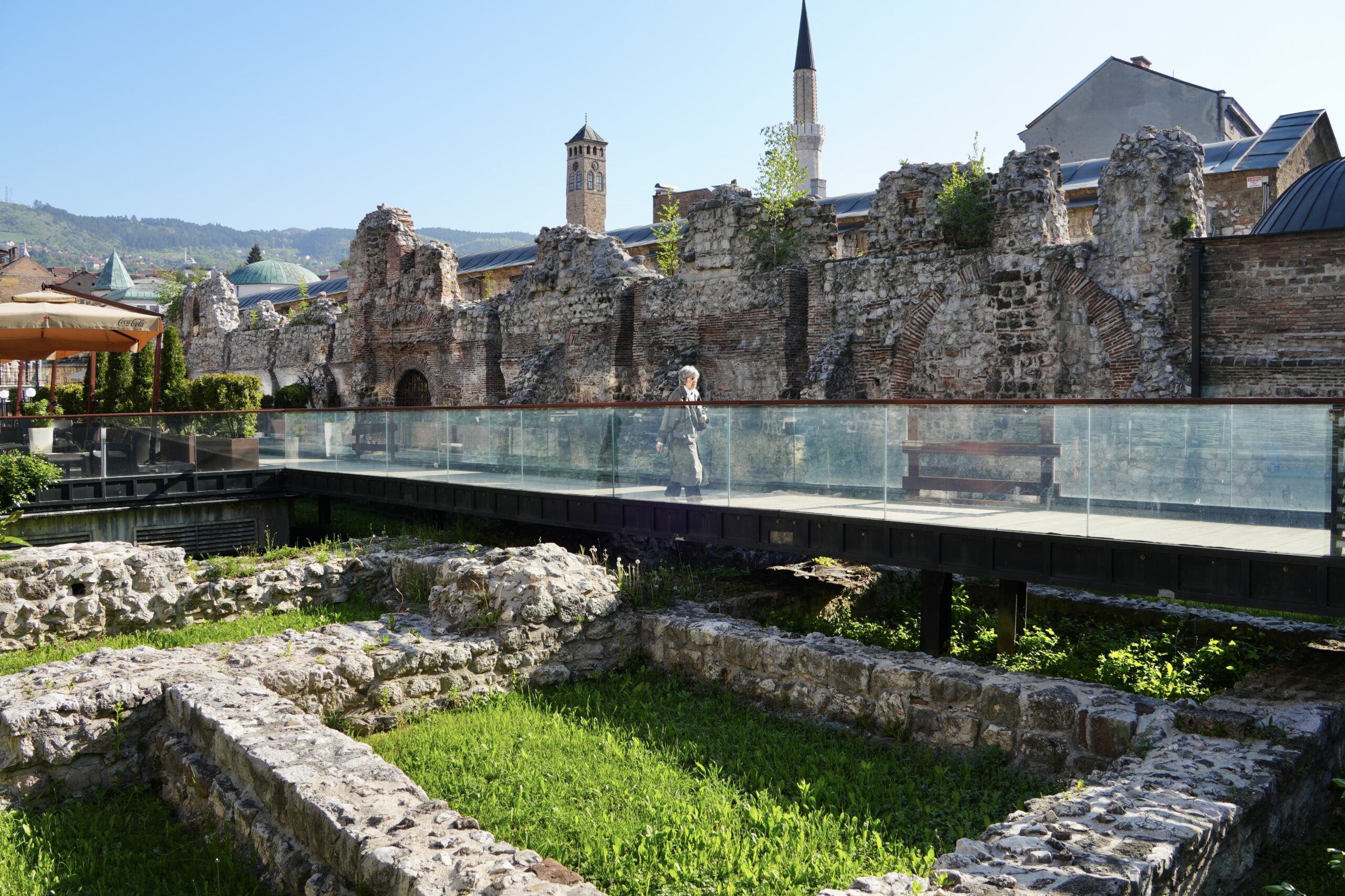
East Meets West at the Meeting of Cultures Line
There is an actual line painted onto Ferhadija Street where the city changes from the Ottoman Baščaršija to the newer Austro-Hungarian part. The “Sarajevo Meeting of Cultures” line is where the east meets the west. Check out the difference in architecture on the two sides. To the east is the older Ottoman buildings we have been exploring so far in this post. To the west, all the buildings have a grander and much taller European style. These were all built after the Austro-Hungarian empire’s occupation of the area began.
Eternal Flame WWII Memorial
The Eternal Flame is in honor of the sacrifices and lives lost during WWII. The flame has burned continuously since 1946 with the exception of during the Siege of Sarajevo (1992-1995). It can be found at the end of the busy pedestrian street of Ferhadija in the Austro-Hungarian part of Sarajevo.
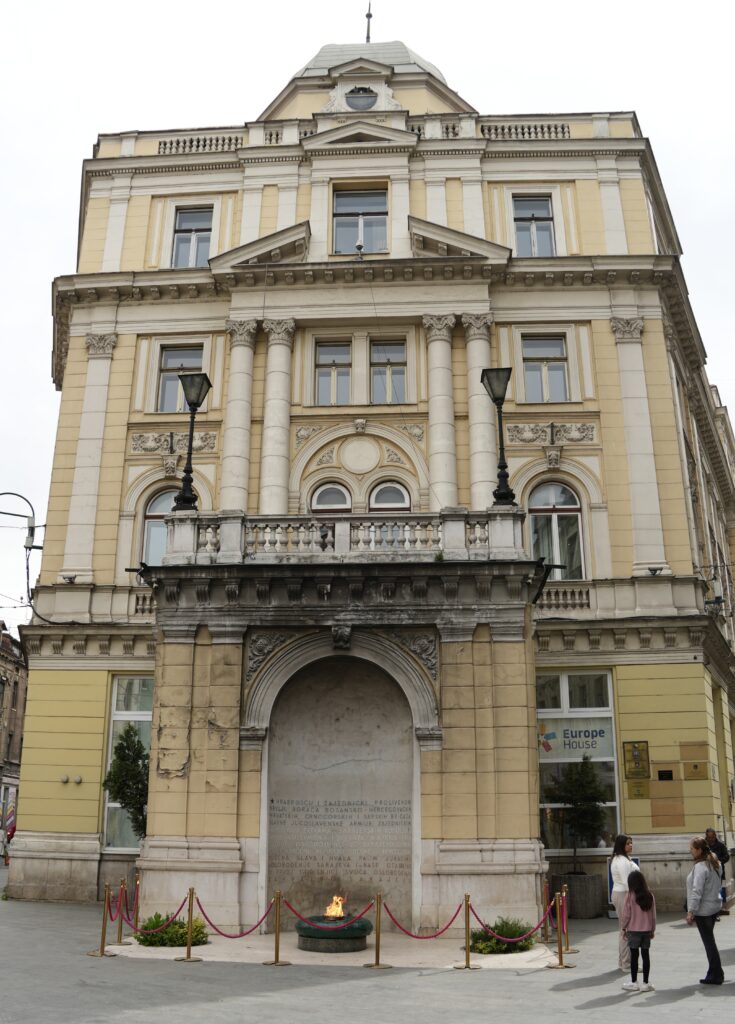
See the Assassination Site of Archduke Franz Ferdinand
The famous assassination that triggered events leading to World War I occurred on the street just north of the Latin Bridge. There are even footprints imprinted into the cement marking the place that Bosnian Serb nationalist Gavrilo Princip stood when he took the fatal shot that killed the Archduke Franz Ferdinand, the presumed heir to Austro-Hungary. A group of Bosnians worked together to carry out the assassination. The motivation of the assassination was to free Bosnia and Herzegovina of Austro-Hungarian rule and create a united South Slav state.
The building next to the imbedded footprints is a tiny museum dedicated to the occupation of the Austro-Hungarian Empire and the day of the assassination. If you don’t know the events that occurred, it might be worth a visit as it is pretty cheap. Just go in knowing it is just a tiny room, a few items on display, and a short video reenacting the assassination.
Walk Across the Latin Bridge
The Latin Bridge was built in 1798 and is one of the oldest bridges in Sarajevo. It was named after the Catholic neighborhood on the left bank of the Melaka River. As mentioned above, it is at the cross-streets where the assassination occurred.
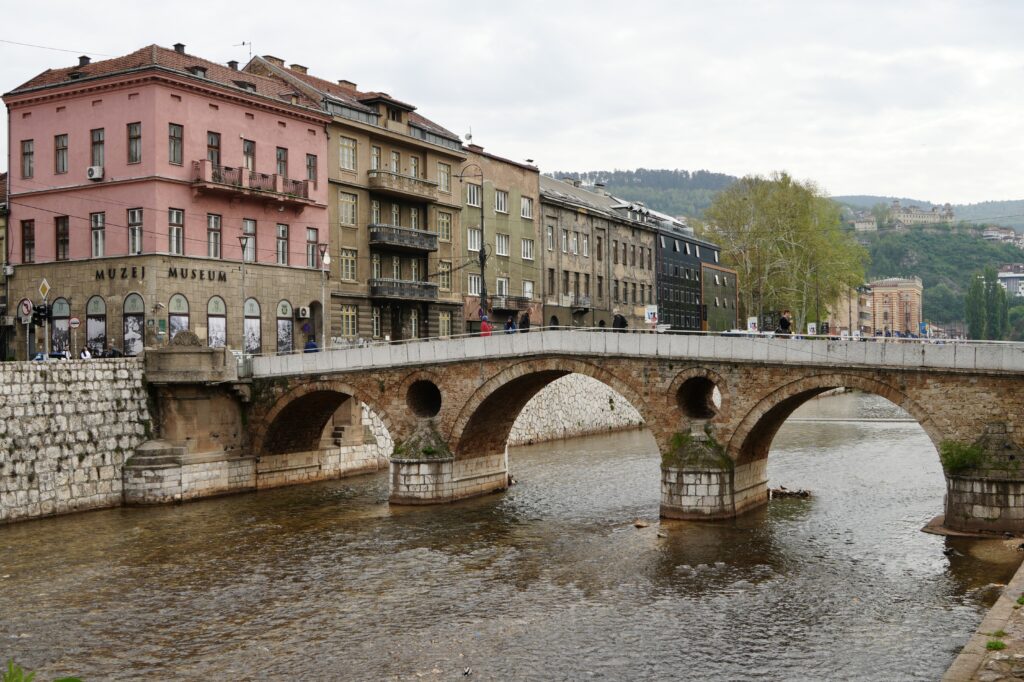
Catholic Sacred Heart Cathedral
The Sacred Heart Cathedral is the main Catholic cathedral in Sarajevo and is located in the Austro-Hungarian side. Construction of the cathedral finished in 1887. It is the largest cathedral in Bosnia and Herzegovina. In 2014, a statue of Pope John Paul II was erected to the right of the main entrance.
Orthodox Cathedral of the Nativity of the Theotokos
The Cathedral Church of the Nativity of the Theotokos is the largest Serbian Orthodox church in Sarajevo. It is located on the edge of Liberation Park just a couple blocks from the Catholic cathedral. Construction of this gorgeous church finished in 1868.
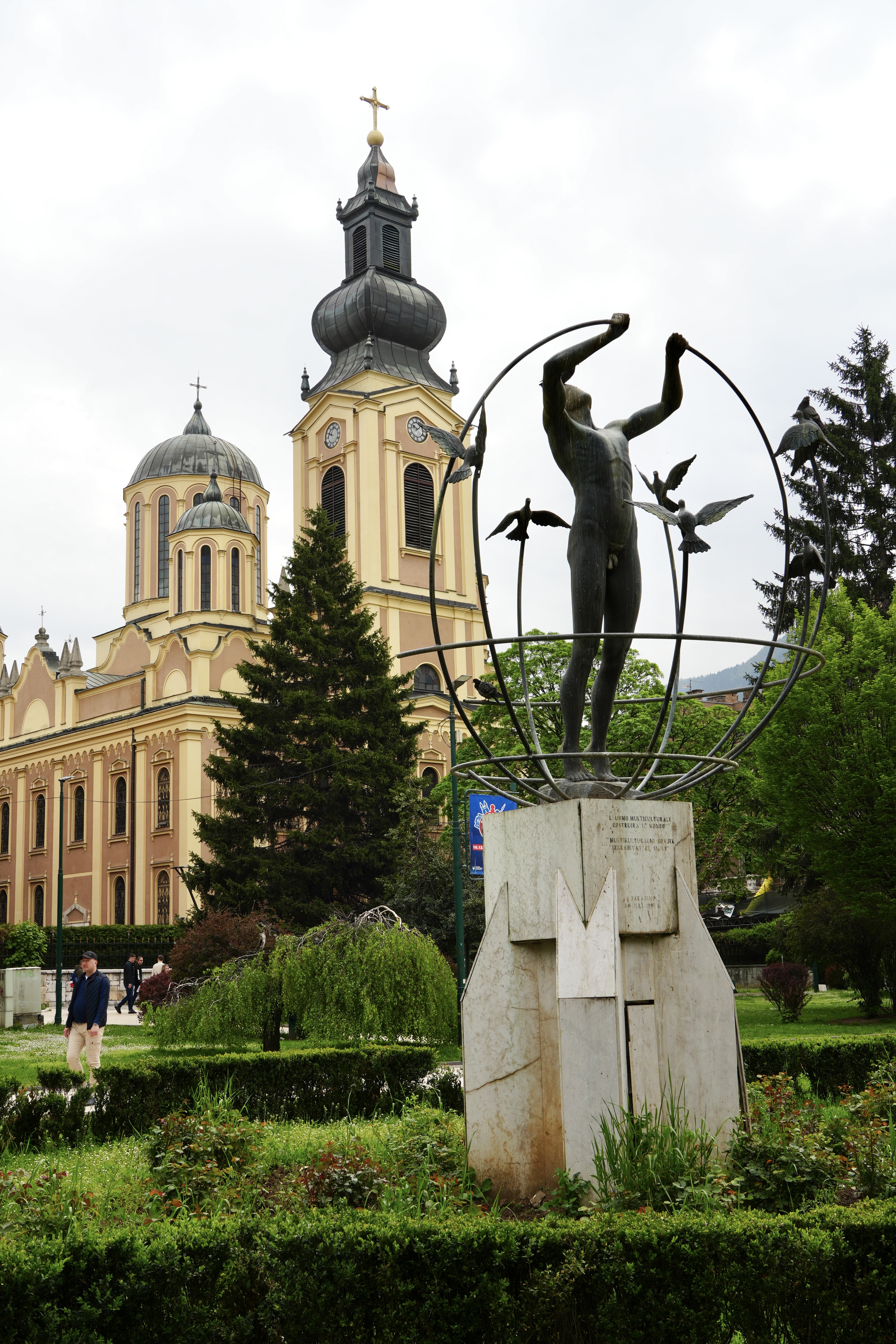
Watch Locals Playing Giant Chess in Liberation Park
Liberation Park is a small park situated right next to the Orthodox Church of the Nativity of the Theotokos. On the south edge of the park is a giant chess board and it is always in use. Older local men take turns playing each other in spirited rivalries while a crowd watches every move. I recommend picking up some local sweets, finding a seat, and watching a game. While there, check out the Multicultural Man Sculpture in the middle of the park. A faceless man stands in the middle of the Earth with 7 doves (representing the 7 continents) surrounding him. He and the doves are trying to connect the meridians of the Earth. There are 6 multicultural Man Sculptures created by an Italian artist on 6 continents around the world.
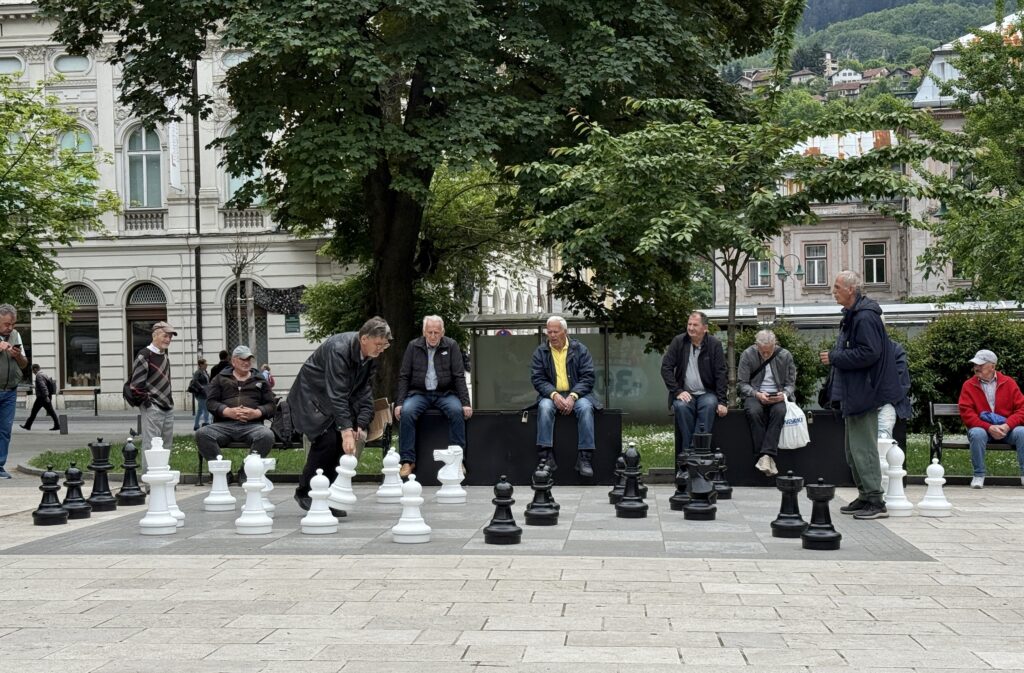
City Hall
City Hall is an example of Austro-Hungarian architecture with a Moorish influence. It was built in 1896 and was the last place the Archduke Franz Ferdinand stopped before he was assassinated. The building was burned in 1992 during the Siege of Sarajevo but restoration began in 1996.
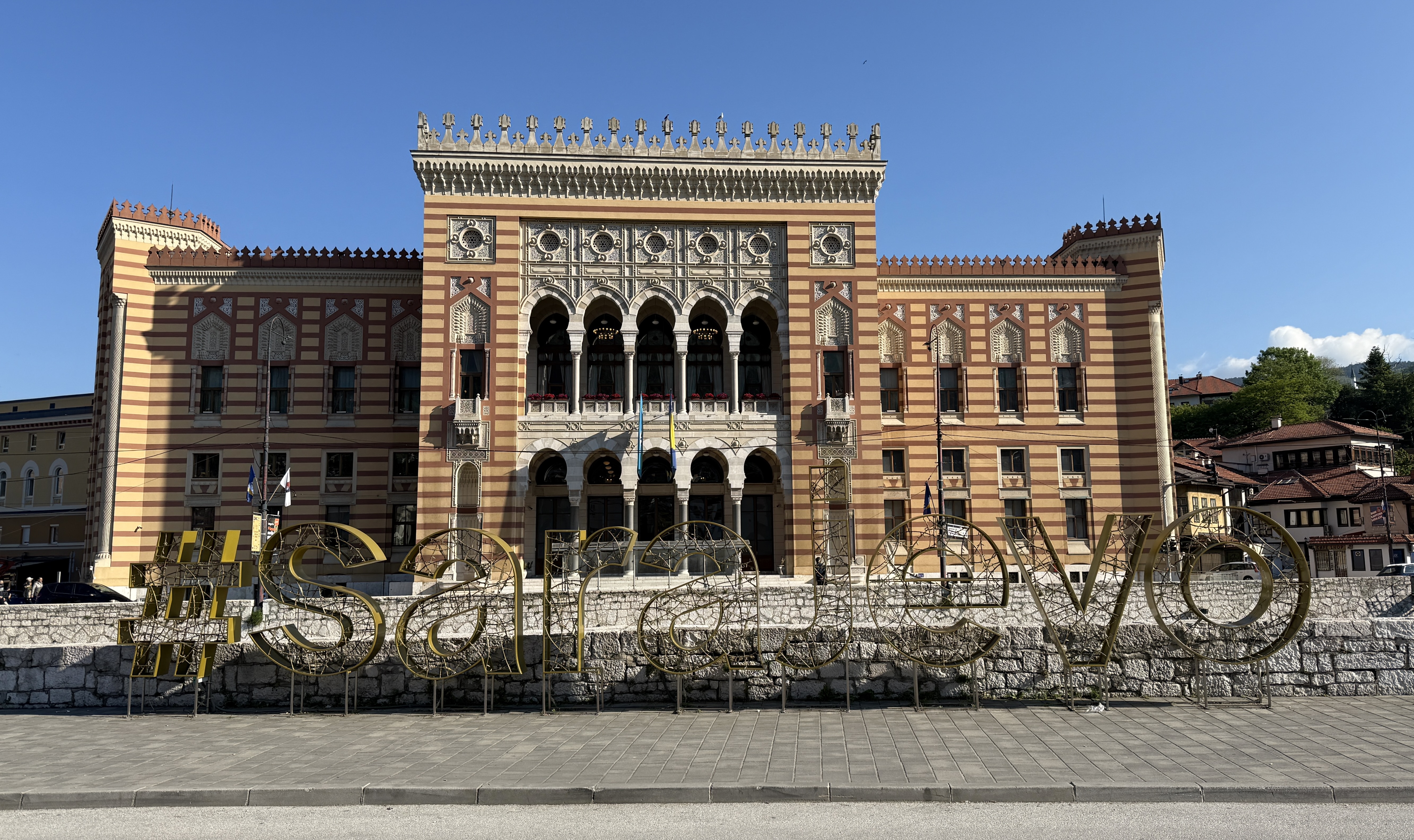
Learn About the Bosnian War
Visit War Museums
I think visiting a couple of these museums might be the most important thing you do while visiting Sarajevo. We first visited the Siege of Sarajevo Museum. It is filled with daily items from people’s lives during the 1,425 day long siege of the city from 1992-1996. Next to each set of items is a story about the person’s experiences during the siege. Some stories were of children growing up in this dangerous time. Other topics were avoiding snipers, getting water, braving the market, fire-fighters, funerals, etc. The museum depicts the struggle of daily life during the siege.
The second museum we visited was the Museum of Crimes Against Humanity and Genocide. I found this museum to be especially impactful. It has a similar setup of showing items and providing personal stories of experiencing these crimes against humanity. There are also photos and video footage of things that occurred during the war.
Bullet-scarred Buildings
Many buildings around the city appear old, damaged, and if you pay attention you will see they are pock-marked. These are holes from bullets and shells during the war. It is unbelievable how many holes are riddled in buildings all around you.
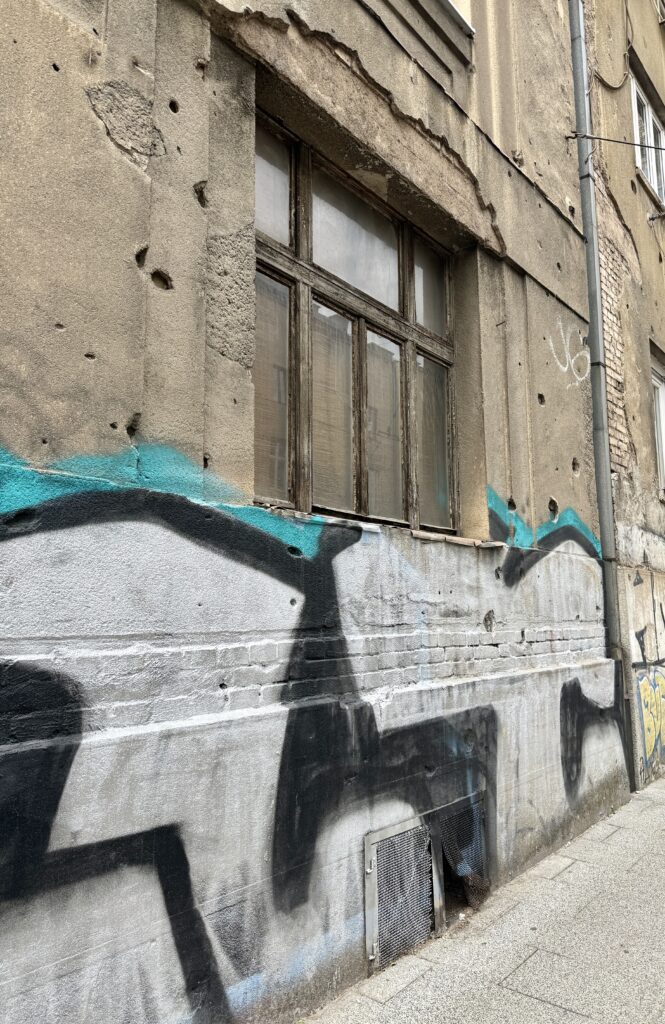
Sarajevo Roses
Look down while walking around as there are signs of the Bosnian War in the pavement as well. They are called “Sarajevo Roses”. Gouges from exploded mortar shells that killed 3 or more people have been filled with red resin as a kind of memorial. A description and map to these Sarajevo Roses can be found here: sarajevoroses.net The city has kept scars from the war in an effort to not forget and hope it never happens again.
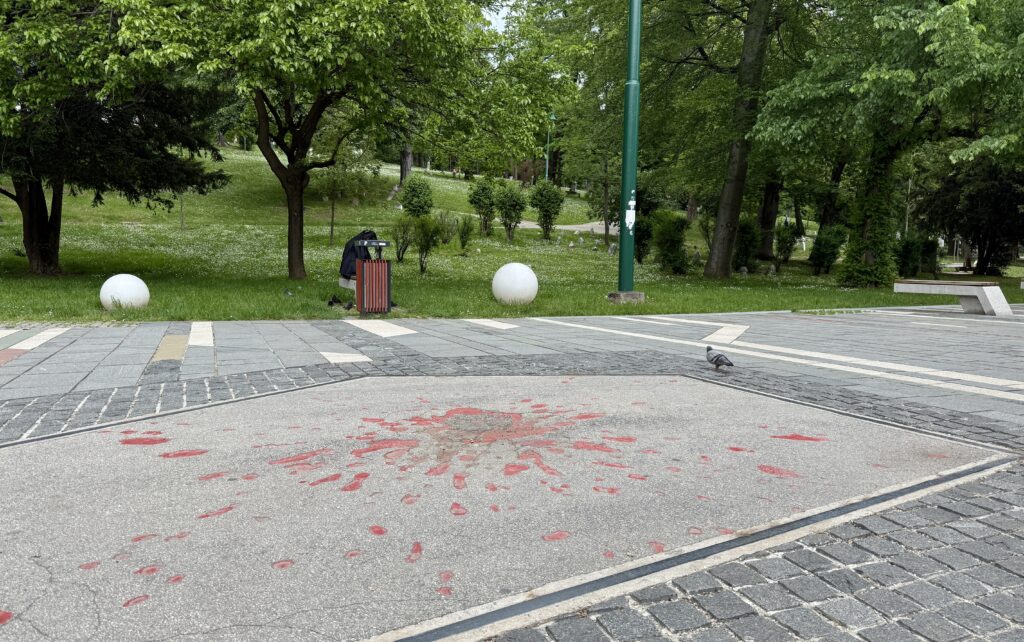
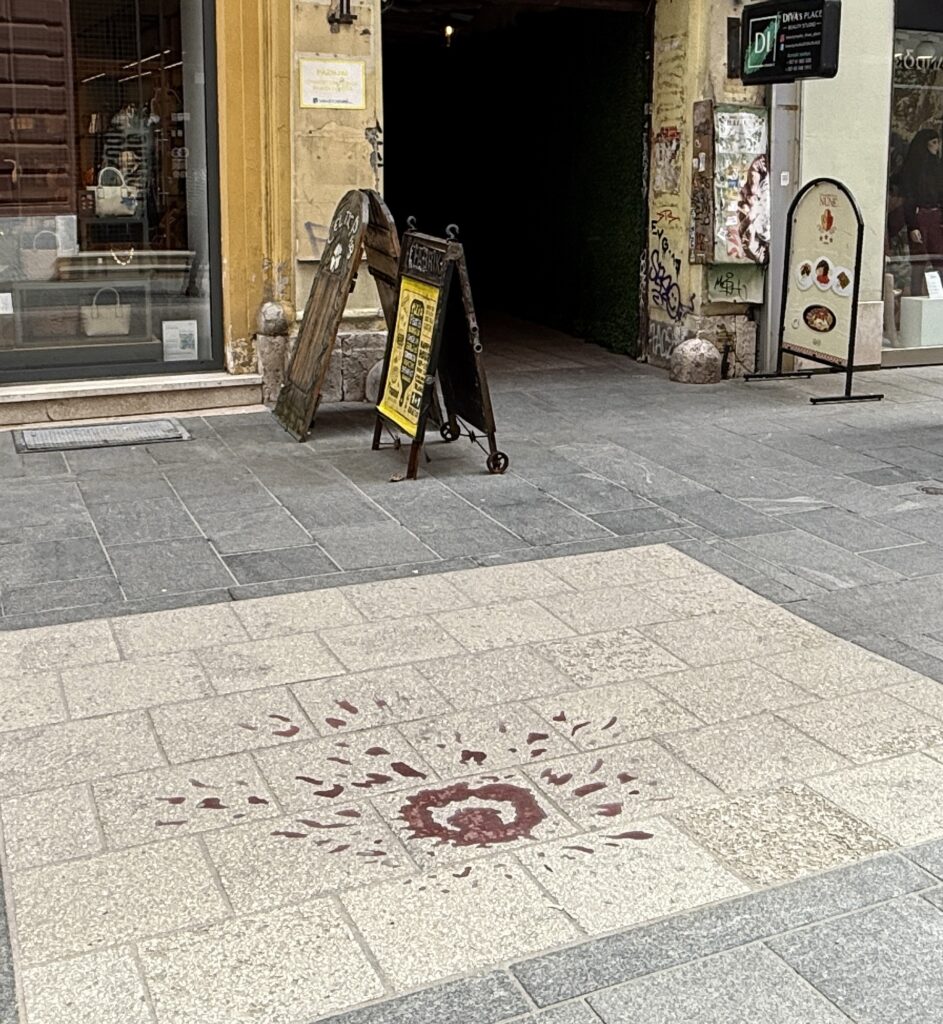
Hike or Ride the Cable Car to Mount Treveviċ
On the south side of the river, the city climbs quickly up the side of Mount Trebević. This beloved mountain is famous for being one of the sites for the 1984 Winter Olympics. Sarajevo is still very proud of having hosted the 1984 Winter Olympics and you will find Olympic rings and references to the event scattered around the city.
A very popular site to visit is the abandoned bobsled track about halfway up Mount Trebević. It is in a state of decay, with moss growing on the old abondoned concrete track. It was damaged during the Siege of Sarajevo when Bosnian Serb forces used it, Mount Trebavić, and the other mountains around the city to cut off and attack Sarajevo. Local artists have transformed sections with beautiful artistic graffiti. You can walk along the colorful track for a short hike.
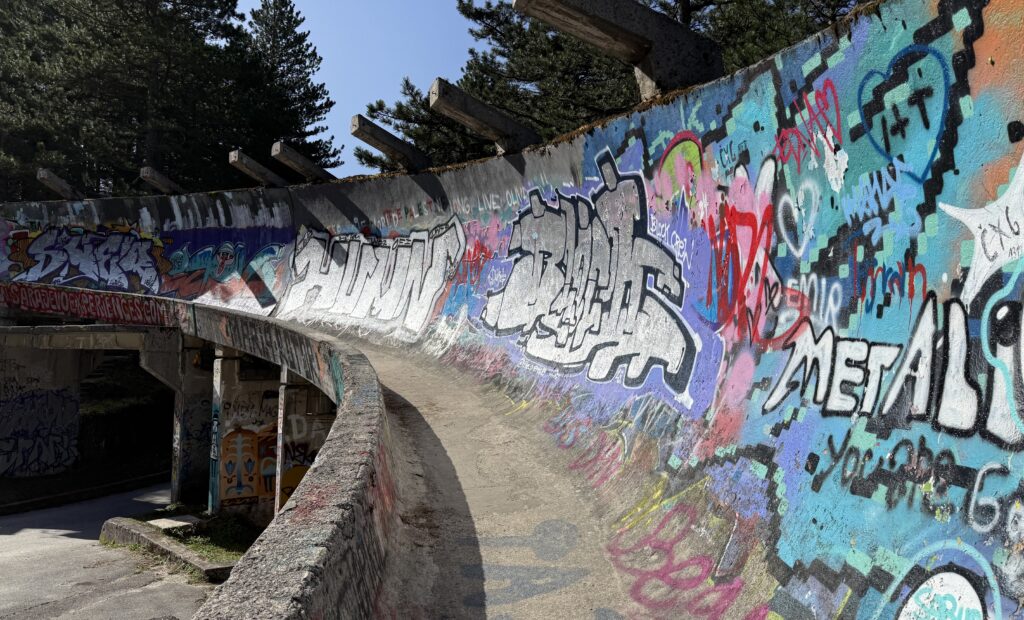
A cable car carries locals and tourists up from the city to about halfway up the mountain. From here, there are nice views looking out over Sarajevo below. It is also near the abondaned bobsled track. At the time we visited, the cost was around 15 euros for a roundtrip ticket. We chose to save money and just hike all the way up to where the cable car drops passengers off.
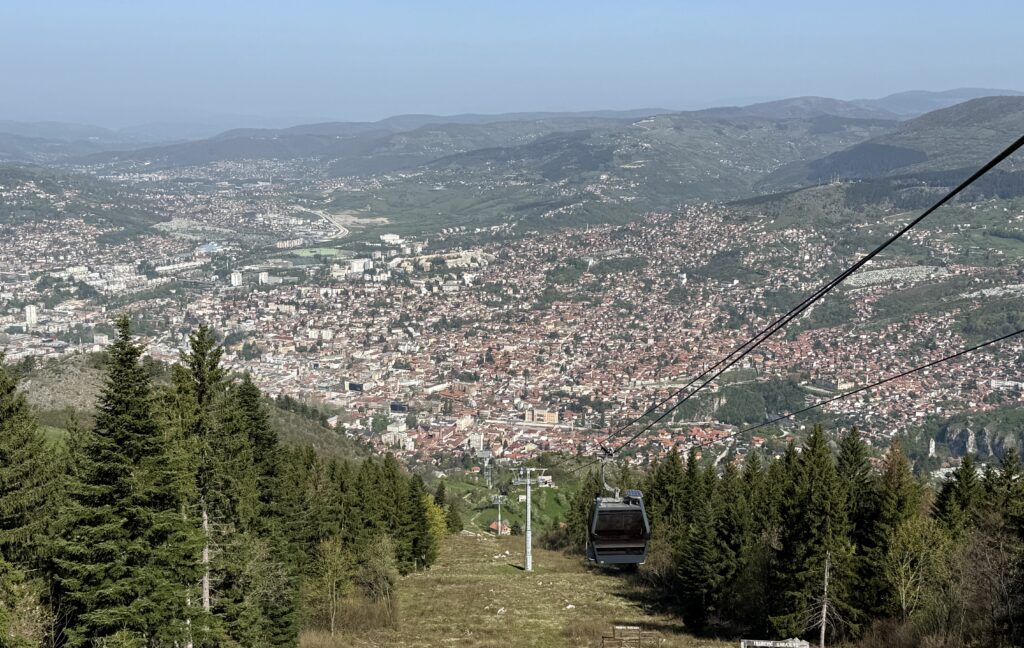
Trails are scattered around this mid-section and continue further up through the forested mountain. We hiked all the way up to the peak of Trebević for great views over the landscapes surrounding Sarajevo. The peak of Trebević sits at an elevations of 5,341 feet (1,628 meters) a little over 3,500 feet above the city of Sarajevo.
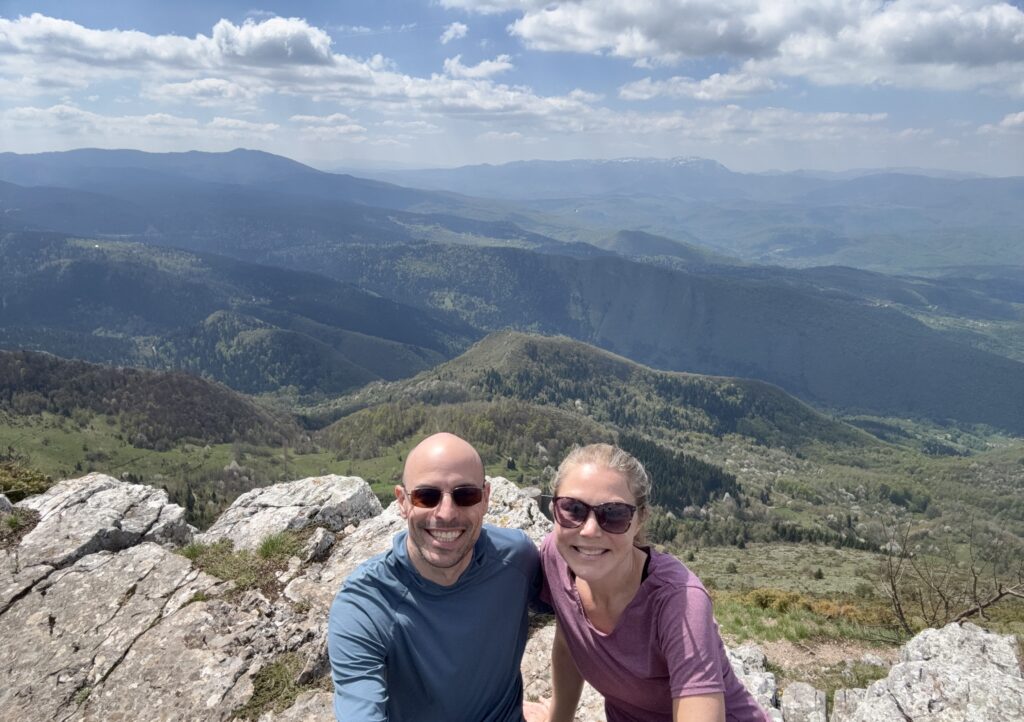
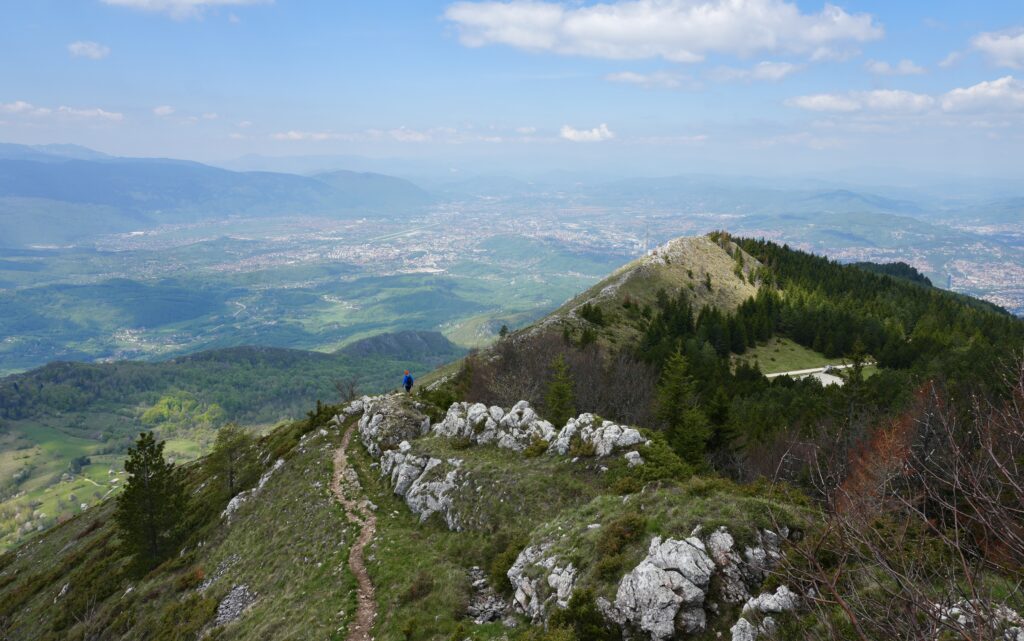
Look for Stećak around the city.
Stećak are medieval tombstones that can be found around the Balkans but most abundantly in Bosnia and Herzegovina. They seem to have been a regional tombstone used by Christians of various churches. They began to appear in the 12th century and then disappeared in the 16th century under Ottoman rule. A bunch of well preserved stećci are able to be viewed for free in front of the National Museum of Bosnia and Herzegovina in Sarajevo.
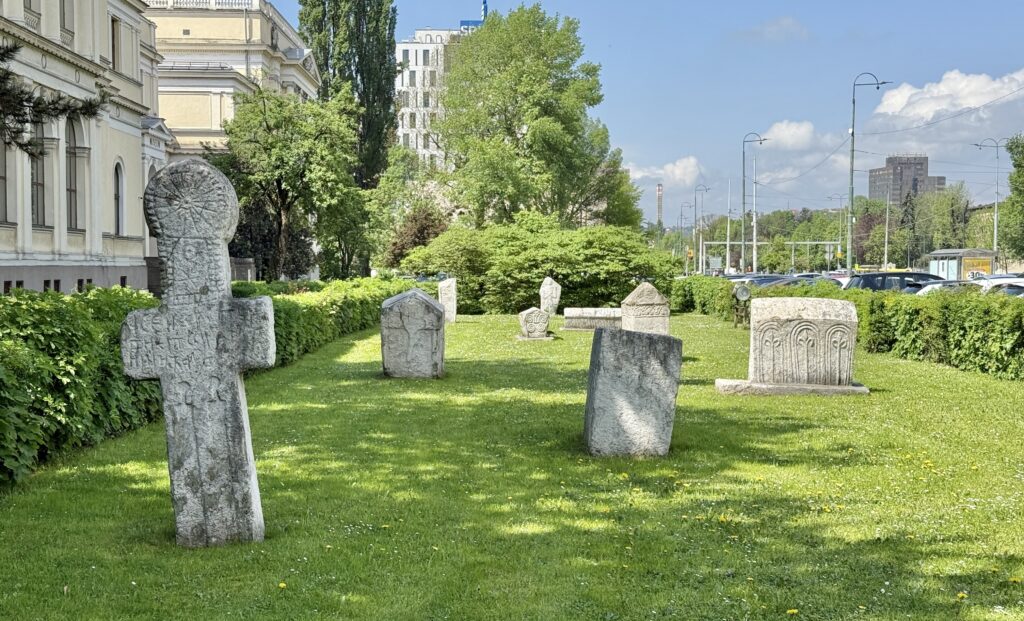
Try Local Food and Drinks
Most of the food in the Balkans is meat, but we did find a couple of vegetarian items to highlight. Our favorite item was the vegetarian versions of burek. Burek is a pastry or pie made from thin flaky dough filled with meat, cheese, potato, and/or spinach. The most common, and what you will likely get in Bosnia and Herzegovina if you just ask for “burek” is a meat one. We absolutely loved the spinach and cheese one. It was called “Zeljanica” and I recommend getting it from the bakery in the Bistrik neighborhood “Pekara Bistrik”.
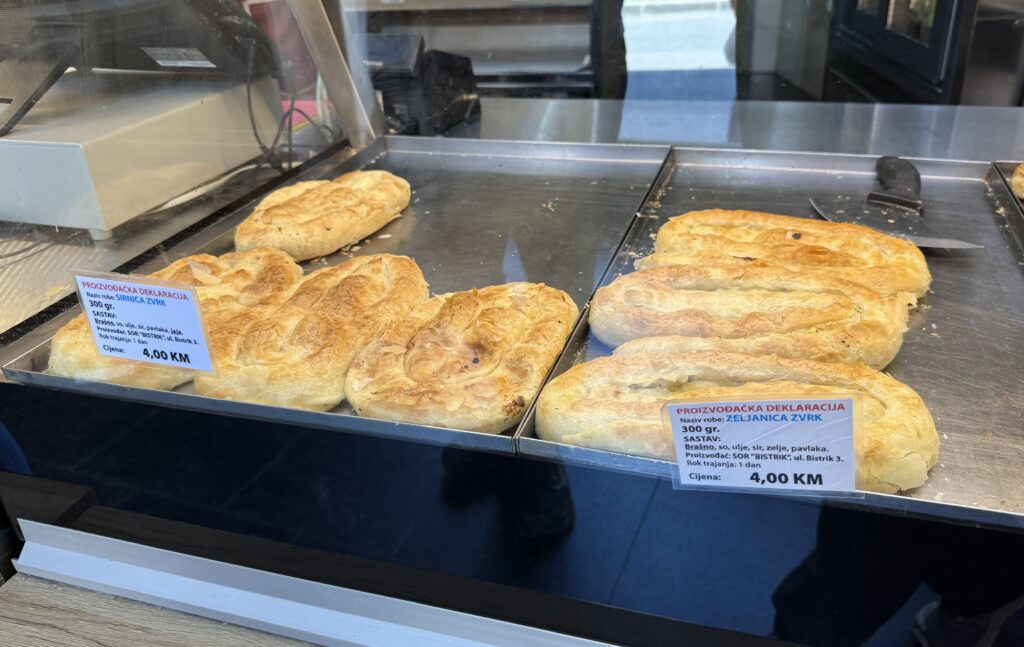
Sweets are on display in windows as you wander through the old town. We tried a few different types of baklava and a desert called “Rabat Lokum”. It’s a sticky gel-like candy that has been rolled in sugar.
For local beverages, there is Bosnian coffee (which is similar to Turkish coffee), rakija, and beer from the local Sarajevo Brewery. Rakija is a sweet brandy often made from plums or grapes and it is really strong. The Sarajevo Brewery beer was our favorite, especially the lemon radler. We could find it in grocery stores, but less often on restaurant menus. I also enjoyed the dark beer (tamno) that Sarajevo Brewery made which was more widely available. The Sarajevo Brewery which opened in 1864 has some interesting history as well. During the Bosnian War the brewery was an important site for locals to get water from. Natural springs run below it and it continued to pump water during the siege to help the city survive.
Enjoy Live Music
We managed to keep ourselves up late enough for some live music a few times while in Sarajevo. City Pub is a dark, unappealing dive bar during the day but stop in at night and it may be filled with locals singing along to local live music. City Pub has live music every night starting around 9:30pm. How exciting the show and experience will be depends on who the performers are so try checking it out a couple times or asking the staff for the most popular act during your stay. The other music venue we enjoyed was Jazzbina. I couldn’t find a show schedule online, so stop by or give them a call to find out when they have live music. We were really impressed with the super talented and large jazz band performing the night we went. Be forewarned that both of these bars will be very smoky. It is unfortunate, but that is just how it is all around Bosnia and Herzegovina. Lots of people smoke and they do it inside.
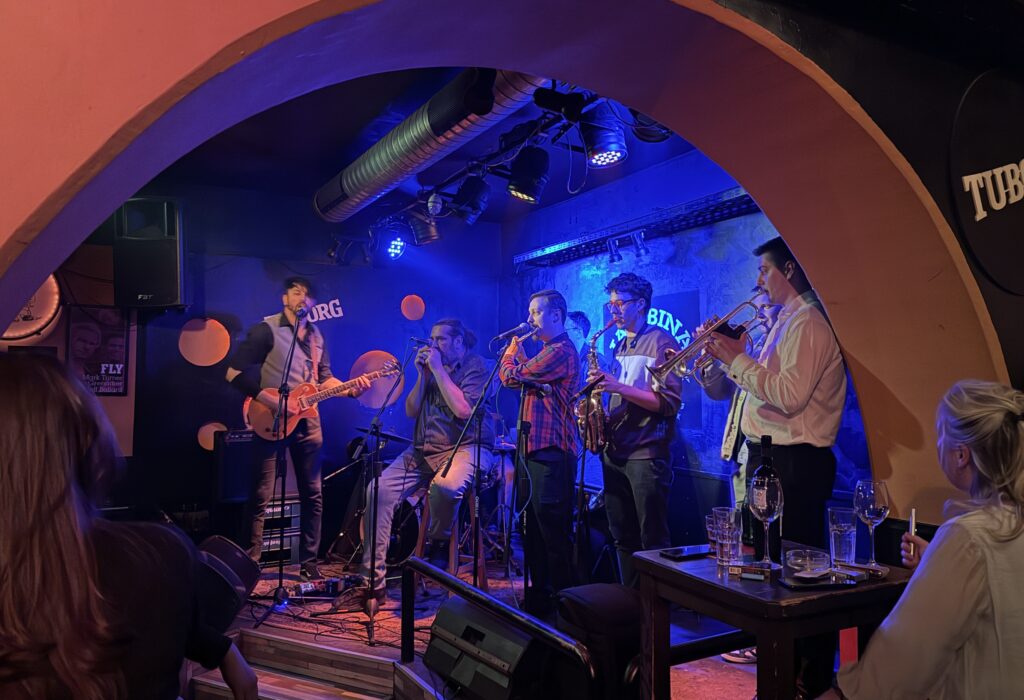
Visit Sutjeska National Park Day Tour
While in Sarajevo we spent a full day on an organized tour to Sutjeska National Park. I really wanted to see the landscapes of a couple national parks in the country, but getting around these areas without your own car seemed impossible and we just weren’t interested in renting/driving during this trip. We found a day tour with Funky Tours to visit Sutjeska National Park and even go on a gorgeous hike in the mountains. Here is a link to that tour: funkytours.com/tour/sutjeska-hiking-tour/
Even just the drive to Sutjeska was exciting. The landscapes became more dramatic along the way, driving through gorges and into the mountains. We stopped at a couple viewpoints in the park then started our hike that would actually take us over the border into Montenegro to see the heart shaped lake named “Trnovačko Lake”. The hike isn’t too difficult, but it is multiple miles and a decent amount of incline, so you will want to be steady on your feet and in decent shape to join this tour.
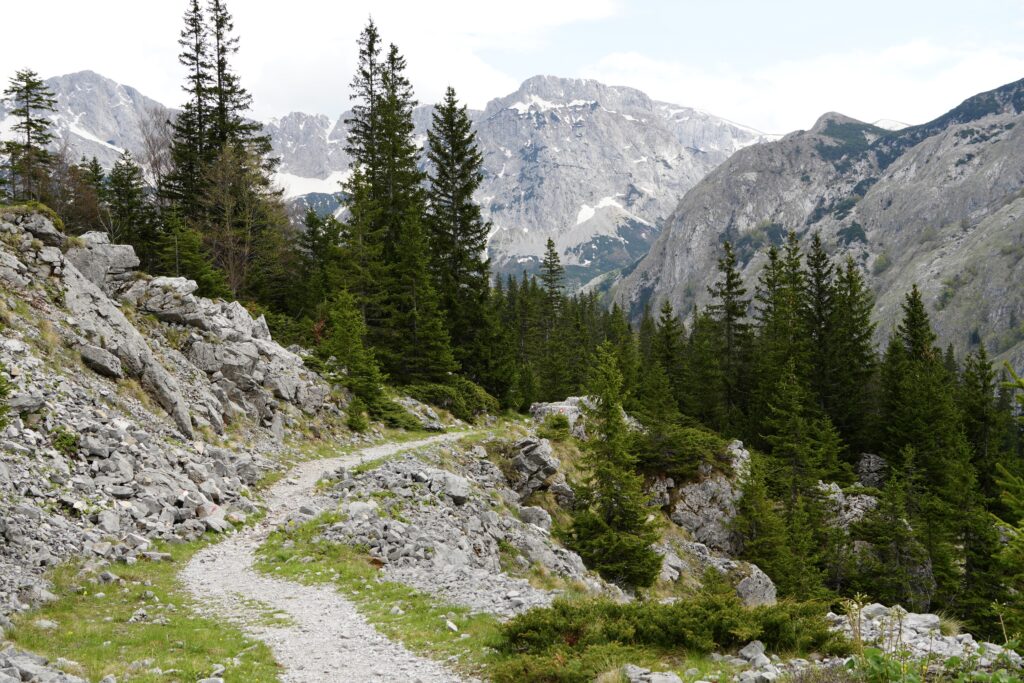
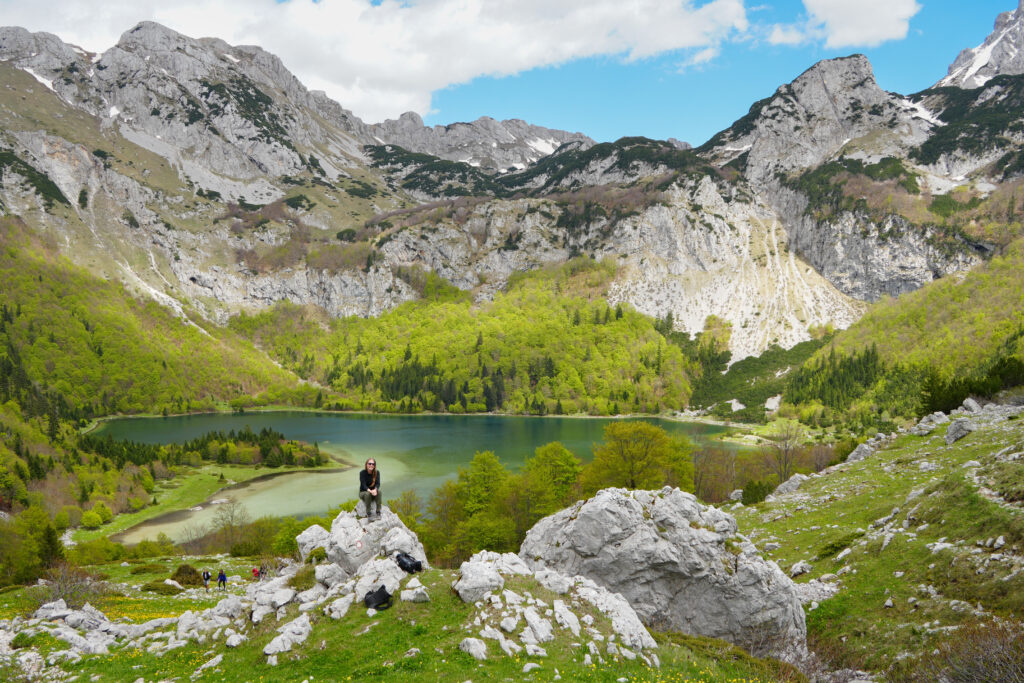
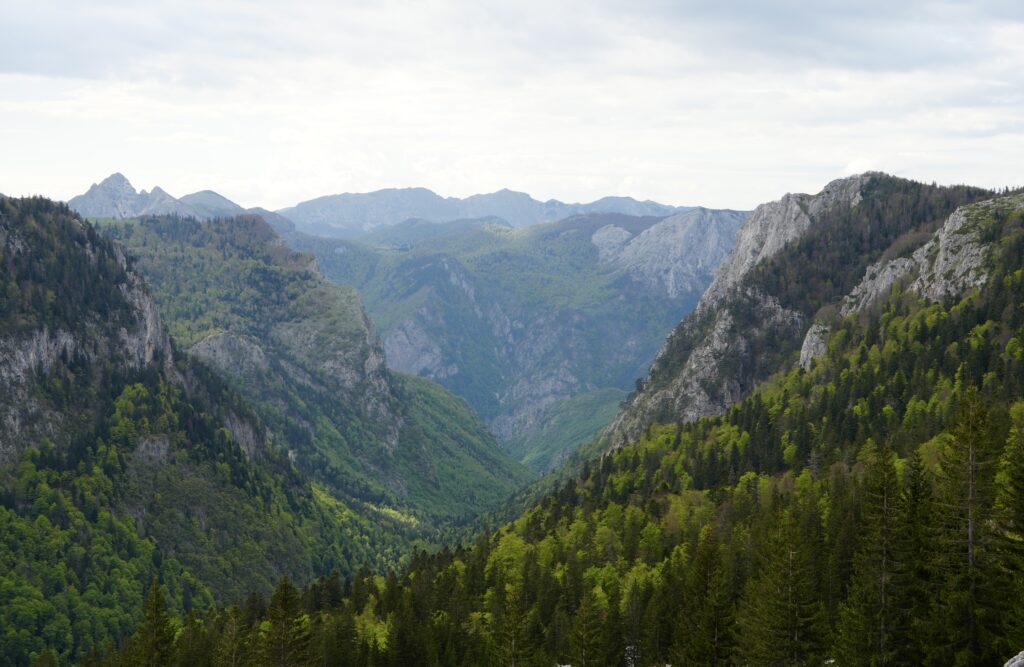
After completing the hike, we had one more stop at a WW2 monument. It is a monument for the fallen soldiers of the Battle of Sutjeska where the Yugoslav partisans beat the German occupying forces in 1943. The tour took all day and we were exhausted by the time we got back to Sarajevo, but it was well worth it!
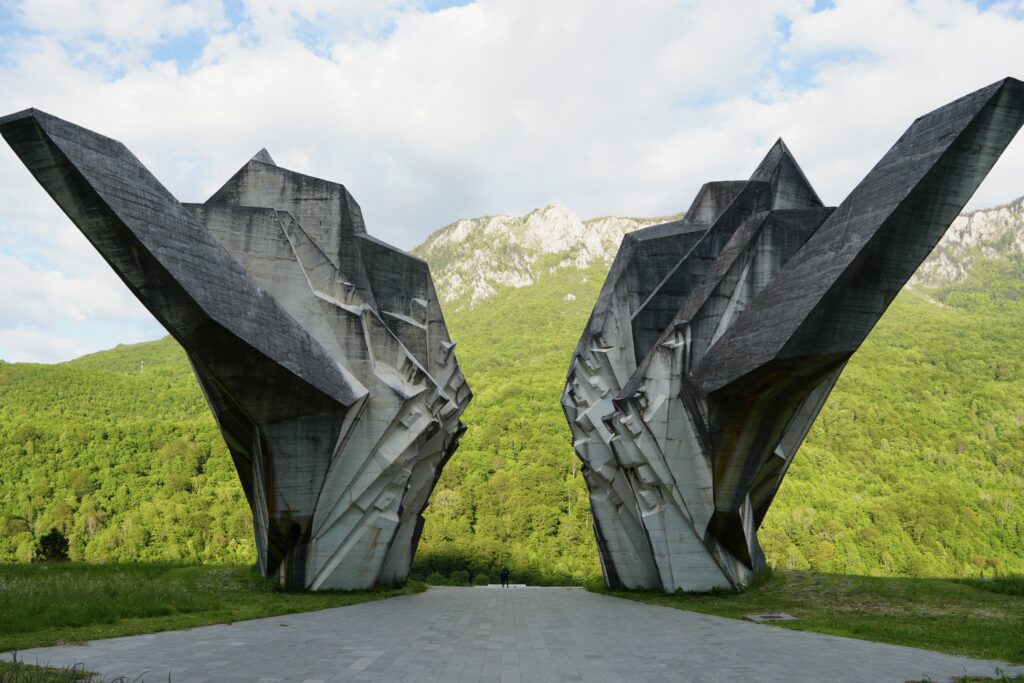
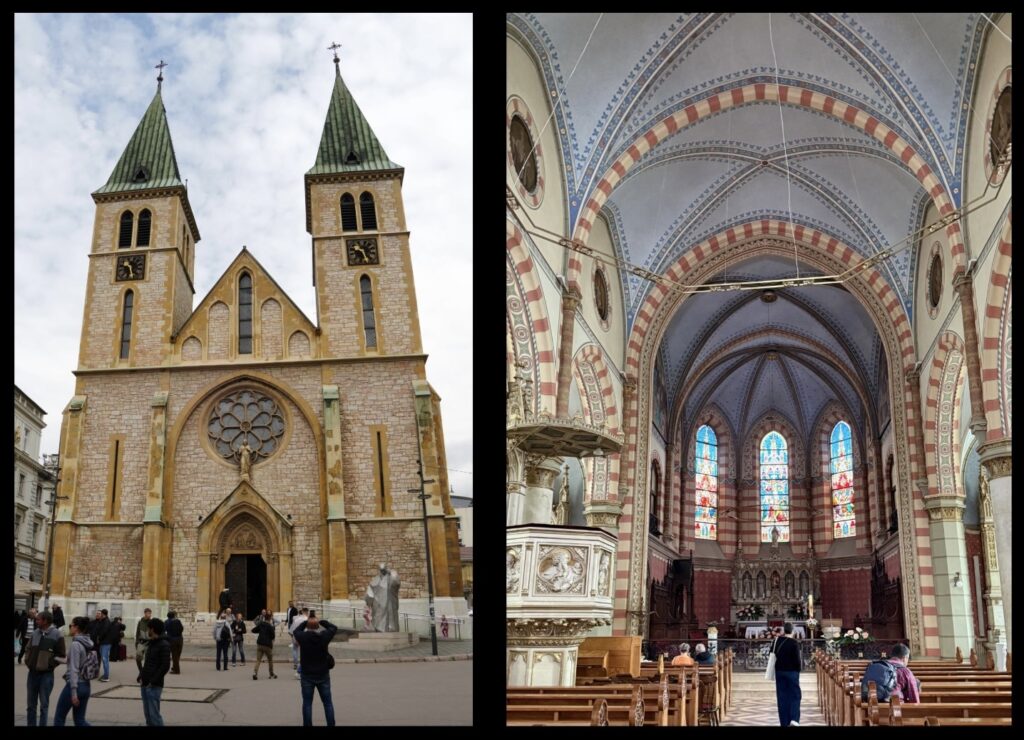
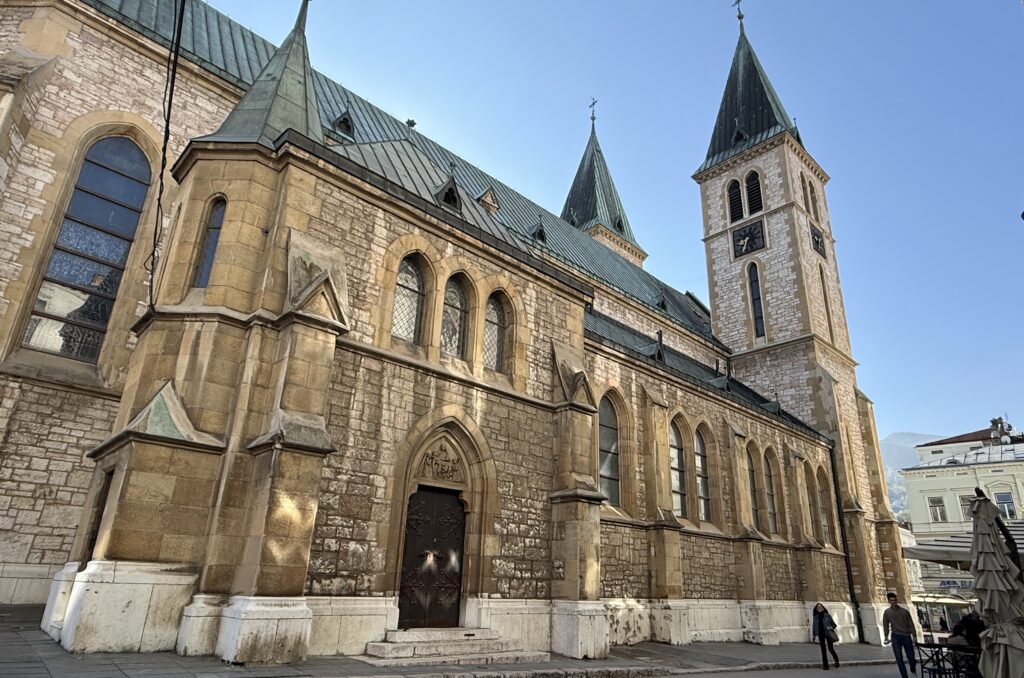
[…] you are interested in hearing more about destinations in Bosnia and Herzegovina, check out my blog on Sarajevo and watch for an upcoming blog about […]